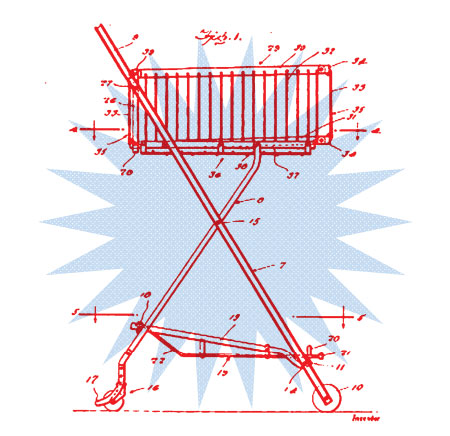the construction of capitalism: the parable of the supermarket shopping trolley
We really do not give them the recognition they
deserve. Not we when we unshackle them, nor when we once again chain them back to their twin brothers and sisters, as we did with the African slaves, having finished using them. As well as that, the odd time we find them requisitioned in village fiestas to be used as an unorthodox method of transport or to be turned over and used as a makeshift barbeque. We use them violently, without care, almost with disdain. Once they were the symbol of a revolution, the symbol of the
capitalist revolution no less. super(market)man
And we owe all of this to the man who came up with the concept of the supermarket: Sylvan Goldman. Sylvan’s parents emigrated from Latvia to the USA. Sylvan was born there in 1898 and when he was 12, he started helping out in the food store where his father worked. During the First World War he was in France working on food provision for the troops. In 1919, when he returned to Breckenridge in Texas, he knew that he wanted to set up his own food shop. He did the very same, but when oil in the area ran out, he moved to California. He was 21 and ready to put his revolutionary idea into practice.
That’s where he set his self-service model in motion. Until then, the customer asked for the goods and the shopkeeper fetched them for them. You needed a lot of shopkeepers who knew a lot about everything in the shop. And time. With the self-service system, the customers themselves gathered what they wanted from goods previously stacked on shelves. Consequently, there were less workers needed, and in a shorter amount of time, more goods could be sold. As Goldman said to a reporter: “Food is the best; everybody consumes it, and only once to beat.” That said, it was a time of crisis, and the business looked very shaky. Goldman reckoned it was time for a new revolution.
the shopping trolley
And, truth be told, he also undeniably had luck on
his side because in the 1930s a new element that
would change food consumption habits appeared: the domestic fridge. By the end of the decade, 50%
of American households had a fridge. Not only that, along with the fridge, new preservatives came along that enabled a large increase in the amount of tinned foods available. Goldman quickly recognised the new situation brought about by joining these two new elements: on the one hand, consumers could buy more food, and on the other, these new foods were too heavy for the traditional baskets and paper bags. As he sat
on his chair in his office, he hit upon the idea. What would happen if the baskets used in supermarkets until then were set atop wheels?
It was a magnificent idea. Clients could get more
products and easily transport them around the store as they shopped. Having designed and built the trolleys, he placed them at the entrance to the supermarkets, proud as punch of his new invention. But shoppers didn’t like the idea because the female shoppers had enough on the plates with hauling their baby pushchairs around. It wasn’t very masculine for male shoppers to be seen pushing a trolley either. But Goldman, convinced his idea was good (and of course that it was good for business), set up an advertising campaign to promote the use of the trolleys. He even hired actors to do their shopping with the trolleys. And little by little, the aisles of the supermarkets began to be taken over by said goods transporters.
Thanks to these trolleys, supermarket sales multiplied. According to research, those who shop in supermarkets tend to fill trolleys when we shop, as if piling up shopping goods was engrained into our DNA. And those like Goldman know this. A simple fact: in the last 20 years, shopping trolleys have doubled in size. The creator of the supermarket trolley, symbol of the
‘American dream’, died in 1984. His invention has
become an icon of the ¨shopping¨ concept.
Isn’t the history of the supermarket trolley beautiful? How many different ramifications and how unusual! Who would ever have said that the trolleys that we release once we have parked our cars in those massive carparks at those massive shopping centres would be so important in our shopping habits. The secret to its success, a clear idea and the unrelenting effort of a businessman. While we were researching this
topic, we were unable to find out anything about the conditions Goldman’s workers worked under, nor could we discover the differences in cost price paid to food producers and sale prices in the stores. But why would you want to do that? And spoil the beautiful parable of capitalism with all that nonsense.
deserve. Not we when we unshackle them, nor when we once again chain them back to their twin brothers and sisters, as we did with the African slaves, having finished using them. As well as that, the odd time we find them requisitioned in village fiestas to be used as an unorthodox method of transport or to be turned over and used as a makeshift barbeque. We use them violently, without care, almost with disdain. Once they were the symbol of a revolution, the symbol of the
capitalist revolution no less. super(market)man
And we owe all of this to the man who came up with the concept of the supermarket: Sylvan Goldman. Sylvan’s parents emigrated from Latvia to the USA. Sylvan was born there in 1898 and when he was 12, he started helping out in the food store where his father worked. During the First World War he was in France working on food provision for the troops. In 1919, when he returned to Breckenridge in Texas, he knew that he wanted to set up his own food shop. He did the very same, but when oil in the area ran out, he moved to California. He was 21 and ready to put his revolutionary idea into practice.
That’s where he set his self-service model in motion. Until then, the customer asked for the goods and the shopkeeper fetched them for them. You needed a lot of shopkeepers who knew a lot about everything in the shop. And time. With the self-service system, the customers themselves gathered what they wanted from goods previously stacked on shelves. Consequently, there were less workers needed, and in a shorter amount of time, more goods could be sold. As Goldman said to a reporter: “Food is the best; everybody consumes it, and only once to beat.” That said, it was a time of crisis, and the business looked very shaky. Goldman reckoned it was time for a new revolution.
the shopping trolley
And, truth be told, he also undeniably had luck on
his side because in the 1930s a new element that
would change food consumption habits appeared: the domestic fridge. By the end of the decade, 50%
of American households had a fridge. Not only that, along with the fridge, new preservatives came along that enabled a large increase in the amount of tinned foods available. Goldman quickly recognised the new situation brought about by joining these two new elements: on the one hand, consumers could buy more food, and on the other, these new foods were too heavy for the traditional baskets and paper bags. As he sat
on his chair in his office, he hit upon the idea. What would happen if the baskets used in supermarkets until then were set atop wheels?
It was a magnificent idea. Clients could get more
products and easily transport them around the store as they shopped. Having designed and built the trolleys, he placed them at the entrance to the supermarkets, proud as punch of his new invention. But shoppers didn’t like the idea because the female shoppers had enough on the plates with hauling their baby pushchairs around. It wasn’t very masculine for male shoppers to be seen pushing a trolley either. But Goldman, convinced his idea was good (and of course that it was good for business), set up an advertising campaign to promote the use of the trolleys. He even hired actors to do their shopping with the trolleys. And little by little, the aisles of the supermarkets began to be taken over by said goods transporters.
Thanks to these trolleys, supermarket sales multiplied. According to research, those who shop in supermarkets tend to fill trolleys when we shop, as if piling up shopping goods was engrained into our DNA. And those like Goldman know this. A simple fact: in the last 20 years, shopping trolleys have doubled in size. The creator of the supermarket trolley, symbol of the
‘American dream’, died in 1984. His invention has
become an icon of the ¨shopping¨ concept.
Isn’t the history of the supermarket trolley beautiful? How many different ramifications and how unusual! Who would ever have said that the trolleys that we release once we have parked our cars in those massive carparks at those massive shopping centres would be so important in our shopping habits. The secret to its success, a clear idea and the unrelenting effort of a businessman. While we were researching this
topic, we were unable to find out anything about the conditions Goldman’s workers worked under, nor could we discover the differences in cost price paid to food producers and sale prices in the stores. But why would you want to do that? And spoil the beautiful parable of capitalism with all that nonsense.



